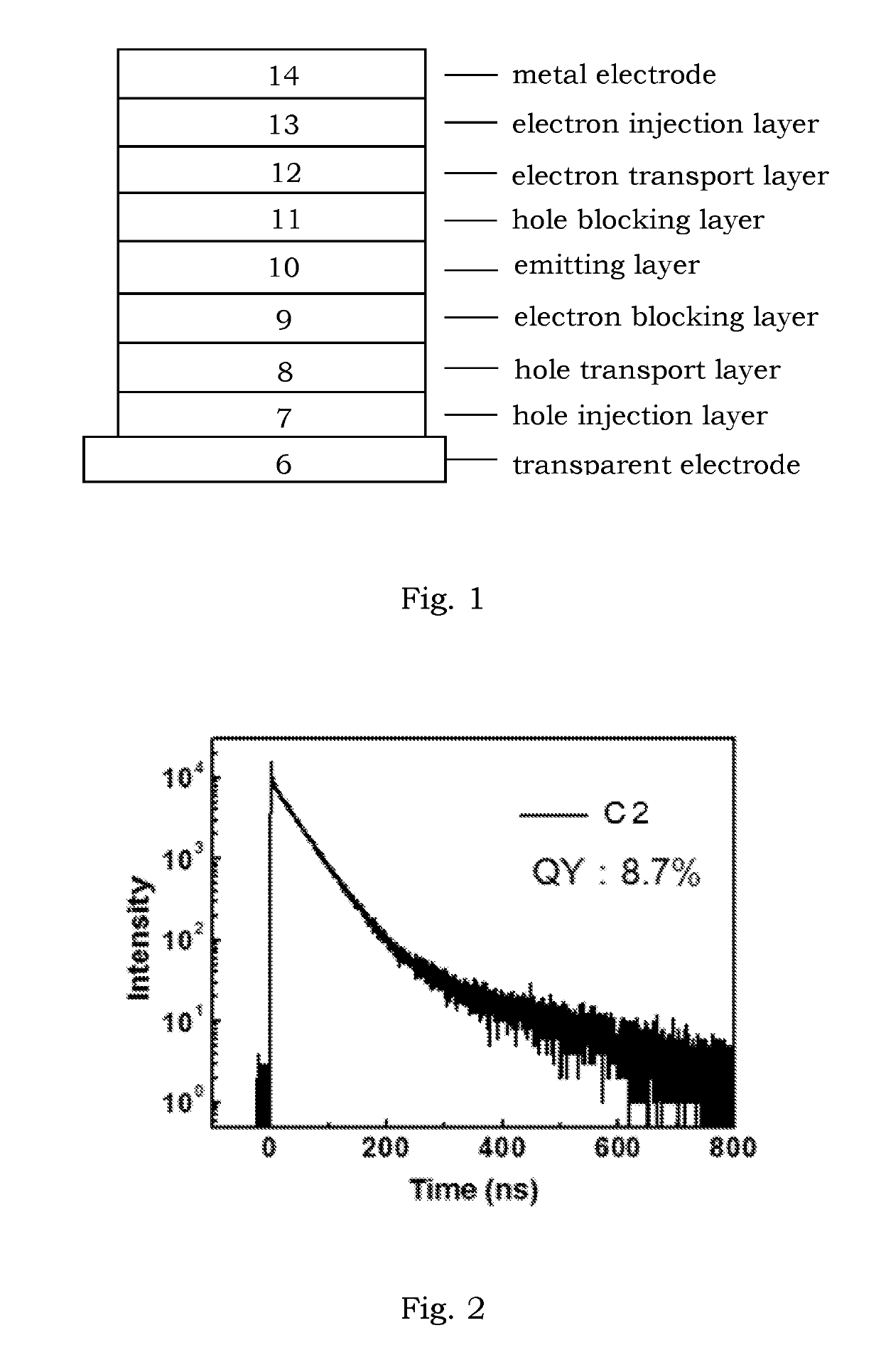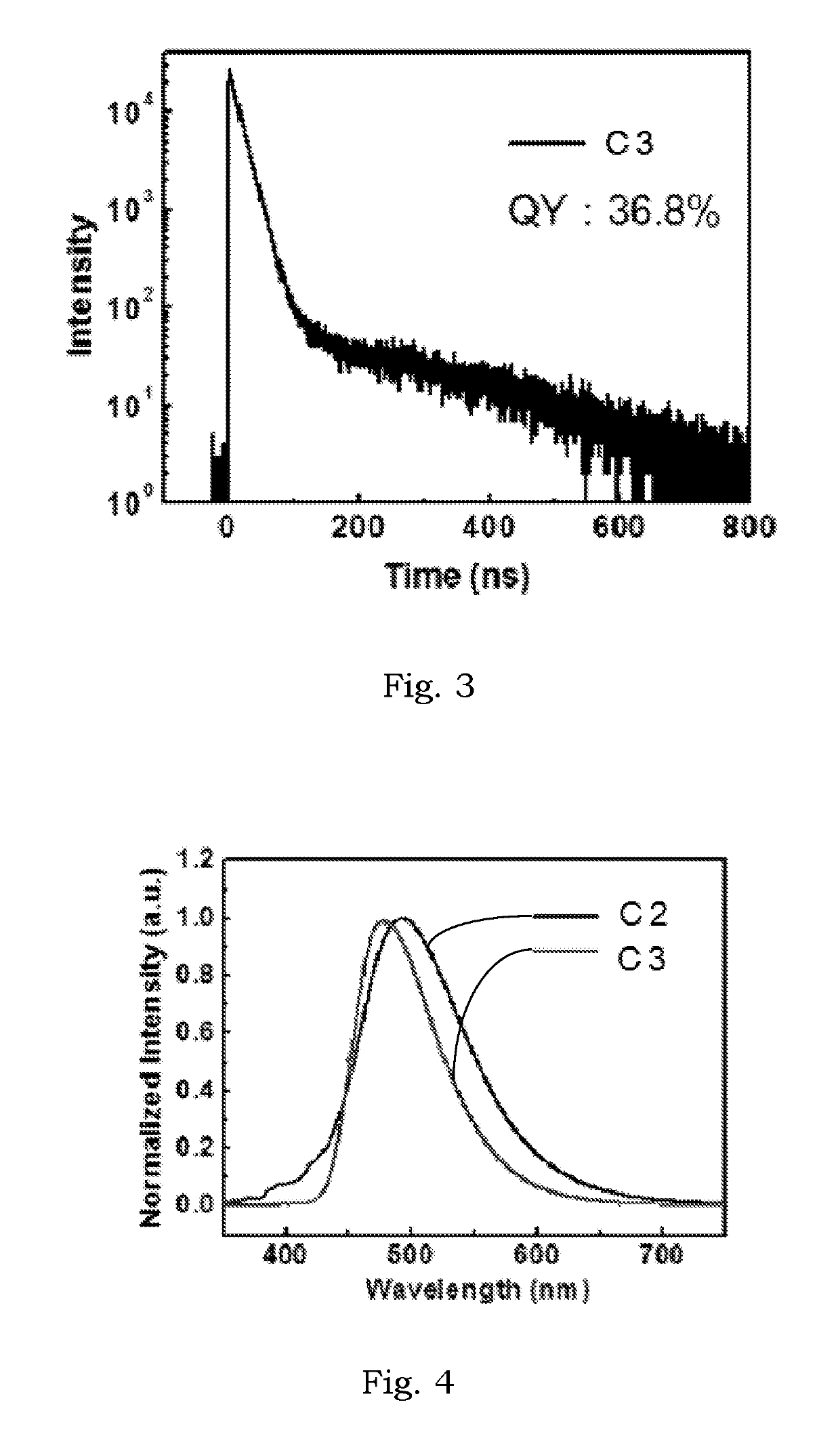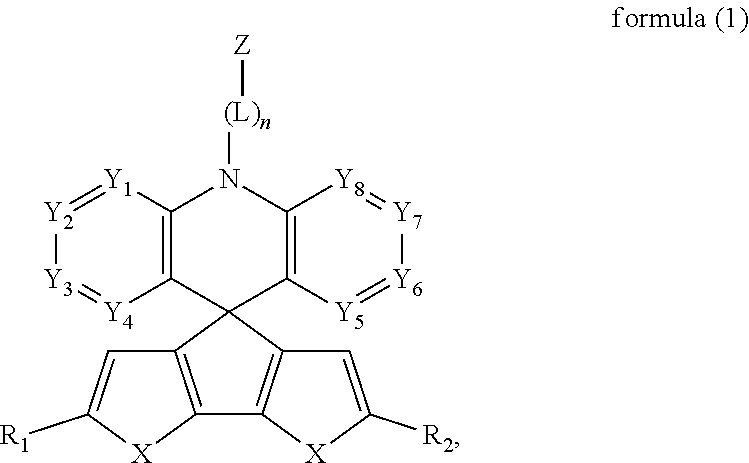Delayed fluorescence compound and organic electroluminescent device using the same
a technology of electroluminescent devices and fluorescence compounds, applied in luminescent compositions, organic chemistry, chemistry apparatus and processes, etc., can solve the problems of red, blue and green doping materials that have been successfully developed, but have not yet reached a satisfactory level, etc., to achieve the effect of increasing the luminous efficiency of the organic el device, reducing driving voltage and power consumption, and high luminous efficiency
- Summary
- Abstract
- Description
- Claims
- Application Information
AI Technical Summary
Benefits of technology
Problems solved by technology
Method used
Image
Examples
example 1
Synthesis of 10H-spiro[acridine-9,4′-cyclopenta[2,1-b:3,4-b′]-dithiophene]
[0037]
[0038]In a 500 ml three-necked flask that had been degassed and filled with nitrogen, 7.1 g (28 mmol) of 2-bromo-N-phenylaniline was dissolved in anhydrous tetrahydrofuran (200 ml) and then cooled to −68° C. Afterwards, 23 ml (58.5 mmol) of n-butyllithium (2.5 M) was slowly added, and then 5 g (26 mmol) of 4′-cyclopenta[2,1-b:3,4-b′]dithiophene-4-one dissolved in anhydrous tetrahydrofuran (40 ml) was added. When the mixture was warmed to room temperature after about 15 hours, the organic layer was separated and extracted with chloroform and water, and then the solvent was removed in vacuo to obtain an intermediate. The intermediate, 2.5 g (26 mmol) of methanesulfonic acid, and 100 ml of chloroform were mixed and then heated at 80° C. for 2 hours. After cooling to room temperature, the organic layer was extracted with dichloromethane and NaHCO3(aq), and then dried with anhydrous magnesium sulfate. Afterwa...
example 2
Synthesis of Compound C3
[0041]
[0042]In a 100 ml three-necked flask that had been degassed and filled with nitrogen, 3 g (8.7 mmol) of 10H-spiro[acridine-9,4′-cyclopenta-[2,1-b:3,4-b′]-dithiophene], 4.2 g (10.5 mmol) of 2-(3-bromophenyl)-4,6-diphenyl-1,3,5-triazine, 0.15 g (0.018 mmol) of Pd2(dba)3, 0.09 g (0.036 mmol) of tri-tert-butylphosphonium tetrafluoroborate, 1.8 g (6.3 mmol) of sodium tert-butoxide, and 60 ml of o-xylene were added, and then heated at 130° C. for 16 hours. After cooling to room temperature, the mixture was filtered to give a solid. The solid was washed with water and MeOH, and then filtered to give compound C3 (4.5 g, 79%) as a dark yellow solid. 1H NMR (CDCl3, 500 MHz): chemical shift (ppm) 9.09 (d, 2H), 8.9 ˜8.8 (d, 4H), 7.68˜7.58 (m, 8H), 7.17 (d, 2H), 7.02 (d, 2H), 6.98 (m, 2H), 6.67 (d, 4H), 6.46 (d, 2H).
example 3
Synthesis of Compound C95
[0043]
[0044]In a 100 ml three-necked flask that had been degassed and filled with nitrogen, 3 g (8.7 mmol) of 10H-spiro[acridine-9,4′-cyclopenta-[2,1-b:3,4-b′]-dithiophene], 3.1 g (10.5 mmol) of 2-bromodibenzo[b,d]thiophene5,5-dioxide, 0.15 g (0.018 mmol) of Pd2(dba)3, 0.09 g (0.036 mmol) of tri-tert-butylphosphonium tetrafluoroborate, 1.8 g (6.3 mmol) of sodium tert-butoxide, and 60 ml of toluene were added, and then heated at 130° C. for 16 hours. After cooling to room temperature, the mixture was filtered to give a solid. The solid was washed with water and MeOH, and then filtered to give compound C95 (4.1 g, 70%) as a dark yellow solid. 1H NMR (CDCl3, 500 MHz): chemical shift (ppm) 7.95-7.91 (m, 3H), 7.60 (d, 1H), 7.50 (d, 1H), 7.45˜7.44 (d, 2H), 7.18 (d, 2H), 7.08 (d, 2H), 6.96 (m, 2H), 6.68 (d, 4H), 6.48 (d, 2H).
PUM
| Property | Measurement | Unit |
|---|---|---|
| triplet energy | aaaaa | aaaaa |
| pressure | aaaaa | aaaaa |
| thickness | aaaaa | aaaaa |
Abstract
Description
Claims
Application Information
 Login to View More
Login to View More - R&D
- Intellectual Property
- Life Sciences
- Materials
- Tech Scout
- Unparalleled Data Quality
- Higher Quality Content
- 60% Fewer Hallucinations
Browse by: Latest US Patents, China's latest patents, Technical Efficacy Thesaurus, Application Domain, Technology Topic, Popular Technical Reports.
© 2025 PatSnap. All rights reserved.Legal|Privacy policy|Modern Slavery Act Transparency Statement|Sitemap|About US| Contact US: help@patsnap.com



